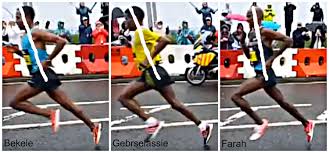Do you want to feel lighter and more free when you run? Then you need to ask yourself, do you know where the front of your ankle joint is? Find the tibiotalar joint labeled ankle in the picture below. This is the front of your ankle. Notice how in the picture on the right, the soft tissue that covers that area is being displayed. All those tendons are what you see pop off your foot and ankle when you bring your toes and foot towards your shin (dorsiflexion).

If you want to be able to run lighter, you need to be able to feel softness in this area and learn how to release the muscles and tendons along the front of the ankle joint when you walk and run.

Take a look at the trailing leg of each of the elite runners above. They are each about to start swinging their back leg forward by flexing the knee and hip. At this moment, you can see how the first thing they have to release before swinging the leg forward, is the front of their right ankle. They have moved into a more pointed foot position not by pushing with their toes into the ground but by releasing the front of the ankle.
By keeping their ankles soft, these great runners able to run lightly and allow their ankles to pass through a greater range of motion than most of us take advantage of. This helps maintain ankle mobility and also limits the amount of calve tension that builds up. The front of their ankles will remain soft for as much of their stride as possible.
If you are constantly dealing with tight and sore calves from regular running, it’s very probable that you are gripping in the ankle.
Try this body tuning exercise to help develop ankle freedom and independence:
First stand comfortable with one of your arms bent at the elbow to 90 degrees. Now shake your wrist out so that it flops all over the place. Nothing specific, just shake the hand and wrist and notice how easy it is for the hand to relax and get thrown around by the bigger muscles around the elbow and shoulder.
Relax and consider if you can do the same thing with your ankle. Try balancing on the right leg with the left foot held comfortably around mid-shin level. First notice, is your left ankle relaxed and dangling in the air, or is it flexed in order to help lift the leg? Then try shaking the left ankle out like you did with your wrist by using the muscles of the knee and hip. Does it feel as floppy as the wrist or do you feel the ankle is like one block?

Notice how the horse above has released the front of its front left ankle in order to swing the front left leg forward, rather casually I might add. This action doesn’t come from pushing the toes into the ground and contracting the calves. It comes from releasing the front of the ankle and allowing the bigger muscles of the hip and knee to take the ankle for a floppy ride. Don’t worry, your ankle will be in the right place when it’s time to land.
Next time you go for a run, use some of your mindfulness to observe the front crease of your ankle. If you can’t feel it releasing before you try to swing your foot forward and your ankle feels heavy, pull over and give yourself a tune up with the shaking exercise.
